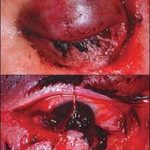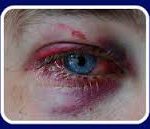
Contents
Eye Injury
Eye injuries can range from the very minor, such as getting soap in one’s eye, to the catastrophic, resulting in permanent loss of vision or loss of the eye. These types of injuries often occur in the workplace, at home, in other accidents, or while participating in sports.
Eye Injuries Causes
- Chemical exposures and burns: A chemical burn can occur in a number of ways but is most often the result of a liquid splashing into the eye. Many chemicals, such as soap, sunscreen, and even tear gas, are primarily irritants to the eye and do not usually cause permanent damage. However, acids and alkalis are highly caustic and may cause severe and permanent damage to the ocular surface.
- Acids (such as sulfuric acid found in car batteries) or alkaline substances (such as lye found in drain cleaner and ammonia) can splash into the eyes.
- Rubbing the eye can transfer chemicals from the skin on the hands to the eye.
- Aerosol exposure is another method of potential chemical injury and includes such substances as Mace, tear gas, pepper spray, or hairspray.
- Subconjunctival hemorrhage (bleeding): This is a collection of blood lying on the surface of the white of the eye (sclera). It is contained by the conjunctiva, which is the membrane that lies over the sclera. Subconjunctival hemorrhage may accompany any eye injury. The degree of subconjunctival hemorrhage is not necessarily related to the severity of the injury.
- Corneal abrasions: The cornea is the transparent tissue that is located in front of the pupil and iris. A corneal abrasion is a scratch or a traumatic defect in the surface of the cornea. People with corneal abrasions often report that they were “poked” in the eye by a toy, a metallic object, a toddler’s fingernail, or a tree branch.
- Traumatic iritis: This type of injury can occur in the same way as a corneal abrasion but is more often a result of a blunt blow to the eye, such as from a fist a club, or an air bag in a car. The iris is the colored part of the eye. It contains muscles that control the amount of light that enters the eye through the pupil. Iritis simply means that the iris is inflamed.
- Hyphemas and orbital blowout fractures: These injuries are associated with significant force from a blunt object to the eye and surrounding structures. Examples would be getting hit in the face with a baseball or getting kicked in the face.
- Hyphemas are the result of bleeding in the eye that occurs in the front part of the eye, called the anterior chamber. This is the space between the cornea and the iris. The anterior chamber is normally filled with clear fluid, called the aqueous fluid.
- Orbital fractures are breaks of the facial bones surrounding the eye. An orbital blowout fracture is a break in the thin bone that forms the floor of the orbit and supports the eye.
- Lacerations (cuts) to the eyelids or conjunctiva (the clear covering over the white of the eye): These injuries commonly occur from sharp objects but can also occur from a fall.
- Lacerations to the cornea and the sclera: These injuries are very serious and are frequently associated with trauma from sharp objects.
- Foreign bodies in the eye: Generally, a foreign body is a small piece of metal, wood, or plastic.
- Corneal foreign bodies are embedded in the cornea and have not penetrated the eye itself. Iron containing metal foreign bodies in the cornea can cause a rusty stain in the cornea, which also requires treatment.
- Intraorbital foreign bodies are located in the orbit (or eye socket) but have not penetrated the eye.
- Intraocular foreign bodies are injuries in which the outer wall of the eye has been penetrated by the object.
- Ultraviolet keratitis (or corneal flash burn): The most common light-induced trauma to the eye is ultraviolet keratitis, which can be thought of as a sunburn to the cornea. Common sources of damaging ultraviolet (UV) light arc welding arcs, tanning booths, and sunlight reflected by snow or water, especially at higher altitudes where UV rays are more intense or by light reflected by snow or water.
- Solar retinopathy: Damage to the central part of the retina can occur by staring at the sun. Common situations that may cause this are viewing solar eclipses or drug-induced states where the person looks at the sun for an extended period of time.
Eye Injuries Symptoms and Signs
- Chemical exposure: The most common symptoms are pain or intense burning. The eye will begin to tear profusely, may become red, and the eyelids may become swollen.
- Subconjunctival hemorrhage (bleeding): Generally, this condition by itself is painless. Vision is not affected. The eye will have a red spot of blood on the sclera (the white part of the eye). This occurs when there is a rupture of a small blood vessel on the surface of the eye. The area of redness may be fairly large, and its appearance is sometimes alarming. Spontaneous subconjunctival hemorrhages may occur in the absence of any known trauma. If it is unassociated with other signs of trauma, it is not dangerous and generally goes away over a period of 4 to 10 days with no treatment.
- Corneal abrasions: Symptoms include pain, a sensation that something is in the eye, tearing, and sensitivity to light.
- Iritis: Pain and light sensitivity are common. The pain may be described as a deep ache in and around the eye. Sometimes, excessive tearing is seen.
- Hyphema: Pain and blurred vision are the main symptoms.
- Orbital blowout fracture: Symptoms include pain, especially with movement of the eyes; double vision that disappears when one eye is covered; and eyelid swelling which may worsen after nose blowing. Swelling around the eye and bruising often occur. A black eye is the result of blood pooling in the eyelids. This can take weeks to disappear totally.
- Conjunctival lacerations: Symptoms include pain, redness, and a sensation that something is in the eye.
- Lacerations to the cornea and the sclera: Symptoms include decreased vision and pain.
- Foreign bodies:
- Corneal: A sensation that something is in the eye, tearing, blurred vision, and light sensitivity are all common symptoms. Sometimes, the foreign body can be seen on the cornea. If the foreign body is metal, a rust ring or rust stain can occur.
- Intraorbital: Symptoms, such as decreased vision, pain, and double vision, usually develop hours to days after the injury. Sometimes, no symptoms develop.
- Intraocular: People may have eye pain and decreased vision, but, initially, if the foreign body is small and was introduced into the eye at high velocity, people may have no symptoms.
- Light-induced injuries:
- Ultraviolet keratitis: Symptoms include pain, light sensitivity, redness, and a feeling that something is in the eye. Symptoms do not appear immediately after ultraviolet exposure but rather about 4 hours later.
- Solar retinopathy: Decreased vision with a small area of central blurring is the primary symptom.
Major eye conditions
1. Rest and reassure the patient
- Tell the patient not to roll their eye.
- Help the patient to rest in the position of greatest comfort with the injured eye closed.
- If the eye injury is caused by a chemical splash, flush the eye with copious amounts of water.
- Advise the patient to avoid all movement of the head to prevent further eye damage.
- Reassure the patient.
Protect the injured eye:
- Cover the injured eye with a clean eye pad or wound dressing. If there is a large foreign body lodged in the eye, DO NOT attempt to remove it, but pad around the eye socket to avoid pressure.
- Advise the patient to keep the uninjured eye closed if possible to reduce the risk of movement of the injured eye.
Arrange for medical care
- Continue to give reassurance and encouragement to the patient.
- While waiting for the ambulance to arrive, check the patient for any other injuries, particularly if a blow or fall was involved.
- Check the level of consciousness and ensure that the airway is clear.
- Remember that an injury around the eye may be associated with a head injury.
Minor eye conditions:
1. Removal of a foreign body
- Tell the patient not to rub the eye.
- Check whether the foreign material is visible on the white part of the eye.
- Ask the patient to blink several times to try to remove the foreign body by washing it out with tears.
If the object is not removed after several attempts, DO NOT continue because of the risk of scratching the eye surface and causing scarring.
If the foreign object cannot be seen clearly or is over the coloured part of the eye, DO NOT try to remove it.
2. If unsuccessful, the foreign body may not be removed by gentle flushing of the affected eye
- Use a clean jug filled with water and pour a stream of fluid across the injured eye and into a bowl or handbasin. Pour the fluid from the mnose end of the eye toward the outer corner to avoid accidentally flushing the uninjured eye. Tilt head to injured side to aid flushing.
- If unsuccessful, cover the eye with a clean pad and see a doctor.
Snow blindness / welder’s flash:
Excessive glare (or bright light from a welder) can damage eyes. The patient may complain of severe pain in the eye(s), with a ‘gritty’ feeling. The eye may be sensitive to light and may be watery and/or red.



